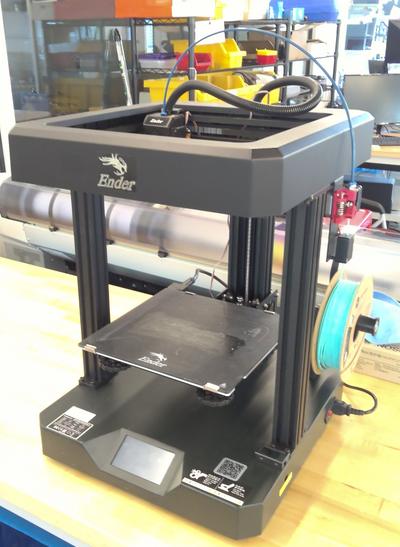Creality Ender7
Overview
The Creality Ender7 is a desktop printer capable of printing faster due to the lightweight carriage design. The build volume is 250mm wide, 250 long, and 300mm tall. This makes this a suitable printer for very long prints.
To fully utilize this printers speed capability, we recommend a profile with 100mm/s printing speed, 20mm/s for the initial layer, and to increase the temperature by 5°C above your filaments recommended temperature (ie, PLA is 190-230, so one would do 215). For a more successful print with Cura, go to Settings>printers>Ender7>Machine Settings>Start Gcode and put G29 in the box to tell the printer to auto-level the bed.
The Ender7 is run in a first-come-first-serve basis. This means that there is no queue to get in line for having your print started. The only way to ensure that you get your print done is to be at the printer when another print finishes and start your print then. The best we can do to help you if you talk to one of the managers is if they know how to work the printer they can start your print at the end of the current one if they would still be present. This is not a guarantee. Managers reserve the right to restart or cancel prints if they look misconfigured (like forgetting support) or is failing. If a print is failing because it needs support and wasn't set properly, we will cancel it and not be able to restart it because the Ender7 needs an updated Gcode file which we cannot create without knowing the specifics of your print.
Training
Trained Managers
here.
| Manager |
|---|
Running a print
These are the very simple steps to be able to print on the CR-30. You should still complete the training on elms for a better understanding.
- Having an idea for a print
- Create a 3D design of your idea using CAD software such as Fusion 360, SolidWorks, or even TinkerCAD.
- There are two options to slice. You can use Creality slicer on the computer in the laser cutting room, or use a slicer that works in your browser at https://grid.space/kiri
- If you're using the link, go to 'Setup','Machine','FDM', under 'Standard devices' select 'Creality CR-30'.
- Make sure if you need support you used it!
- Another important thing to change is the temperatures. Change the nozzle temperature and bed temperature according to the filament you want to use. Not following these steps could damage the printer.
- If using the link, this is under 'Output'.
- After saving the gcode to an SD card, plug it into the CR-30. If you can't support SD cards, you can ask a manager and they can find an adapter.
- Change out the material as needed
- Using the knob on the CR-30, press and turn to the bottom to find 'Print from card'
- Make sure you have enough material left in the current spool to finish your print
- Click on your print to start it
- Hang around the sandbox at least until the first layer is done to make sure your print doesn't fail (Most of prints fail within the first layer)
- If your print fails then take it off and reprint it. If this continues to happen then ask a manager for help or try another print (Please don't waste materials failing the same print over and over)
- Come back whenever your print is done and find it in the Prototype Room and enjoy!
About Creality Slicer
- Creality Slicer can be found for free on Creality's website: Creality Download
- Creality slicer allows 3D file formats: 3MF, OBJ, STL or 2D file formats: bmp, gif, jpg, png.
- You can download Creality slicer or use an online slicer to prepare a print on you own computer and load it onto an SD card for the CR30.
- Possible ways of getting objects to print:
- Finding and downloaded STL or CAD files from Thingiverse, GrabCAD
- Create your own CAD files using a program like Solidworks, Siemens NX, Autodesk, or anything that will create the accepted file formats.
